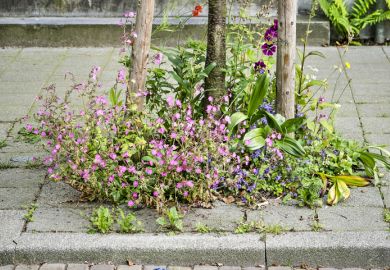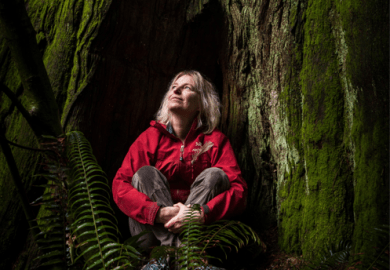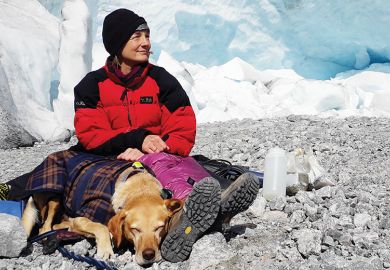I had set aside part of a morning to review this new book about Krakatau. I was wondering how it would be possible to find anything original to say about such a familiar theme. I need not have worried. My plans for the rest of the day were shelved, when I suddenly realised it was getting dark outside and I was still so engrossed in this fascinating book that I could not put it down. This extraordinary text is most certainly not just another volcano book.
Iain Thornton's knowledge of his subject is daunting. He describes the events leading up to the awesome eruption in 1883 that left more than 36,000 people dead, destroyed over 160 towns and villages and wiped out a whole island. He has gone back to original ships' logs and scientific papers and has translated them himself to present a highly readable, informative and gripping story.
Exactly how the fatal tsunamis (tidal waves) that raced across the oceans during the cataclysmic eruption were generated has been the subject of vigorous debate in the scientific literature on and off for over 100 years.
Thornton presents the various arguments precisely but clearly and manages to make the problem accessible to the volcanologist and lay reader alike. There are so many personal anecdotes told as the story of the developing understanding of the processes unravels that, informative as it is, the book has all the intrigue and suspense of a good "whodunit".
But Thornton is a zoologist, and his passion is for the colonisation of what was left of Krakatau after the eruption "wiped the slate clean" and extirpated all life there.
The effect of the eruption was to reduce a once large and lushly vegetated island and its two close neighbours to three smouldering heaps of volcanic rubble. The trees were knocked down by the force of the blast, carbonised and covered with several metres of ash. No plants or animals survived. Only the sketches made by John Webber while anchored off Krakatau in 1780 on the return journey of Cook's last expedition survive to illustrate the diversity of tropical rain forest life before the eruption.
Thornton describes the expeditions that visited the island to chart the progress of recolonisation. Nine months after the eruption, a single small spider was found there that had ballooned across from the mainland on a gossamer thread. By 1905, the reticulated python had arrived. After 25 years, 192 species of insects were identified and the forest was beginning to grow, but still no mammals were found.
At this point, the interactions between personalities in the various scientific groups investigating the recolonisation process become interesting as "the Krakatoa problem" develops. Doubt is thrown on the assumption that all life really was extirpated by the eruption.
One of the problems facing the scientists was the growth of fig trees. Fig plants can only be pollinated by female wasps of a particular species (one for each fig species). The wasp lays her eggs in one fig, damaging it so that it galls but pollinates several others, permitting them to develop to maturity. This is an example of reciprocal parasitism.
So how do fig trees colonise an island without the wasps they need, and how do the wasps colonise an island without the figs they need? Another problem was the divergence of the developing forests on the three islands. Although the islands are close together, and all were "wiped clean" by the same event, they are not being colonised at the same rate or even by the same species.
As if to give the evolutionists and ecologists another chance, Krakatau produced another island in 1930 named Anak Krakatau (Krakatau's child). There can be no question that this was a very clean slate as the island rose from beneath the waves.
There are some complications with Anak Krakatau though. Frequent eruptions devastated the flora and fauna on some parts of the new island. Cliff erosion and migrating coastal spits provided a constantly changing habitat. The colonisation process at this new island was different from that of the islands left after the 1883 eruption too because Anak Krakatau was closely surrounded by increasingly mature vegetation.
A final twist was the effect of the visiting scientists and more recently the tourists on the colonisation process. The black rat and several other animal and plant opportunists have arrived on boats.
This book is a thoroughly good read for the interested lay person and requires no previous knowledge of volcanology or zoology. It is also suitable as a text for volcanologists requiring a detailed account of the 1883 eruption and the debates on explosion versus caldera collapse to account for tsunami generation. The student of ecology or evolution will also find this a fascinating and timely treatment as will the social scientist interested in how science is done. I would also recommend it to anyone planning to visit the area on holiday.
The 3 pages include 32 half- tone figures, 20 line illustrations, one map, three tables and an extensive reference list. Biographical notes at the back on some of the key zoologists, botanists and geologists mentioned in the text are an unusual and interesting addition. The reader "has a glimpse of two sides of the same coin, both the destructive and healing powers of nature, each seeming to exceed by far anything that human power with all its technological aids, can yet achieve".
Hazel Rymer is a university research fellow, department of earth sciences, Open University.
Krakatau: The Destruction and Reassembly of an Island Ecosystem
Author - Iain Thornton
ISBN - 0 674 50568 9
Publisher - Harvard University Press
Price - £25.50
Pages - 3
Register to continue
Why register?
- Registration is free and only takes a moment
- Once registered, you can read 3 articles a month
- Sign up for our newsletter
Subscribe
Or subscribe for unlimited access to:
- Unlimited access to news, views, insights & reviews
- Digital editions
- Digital access to THE’s university and college rankings analysis
Already registered or a current subscriber?



